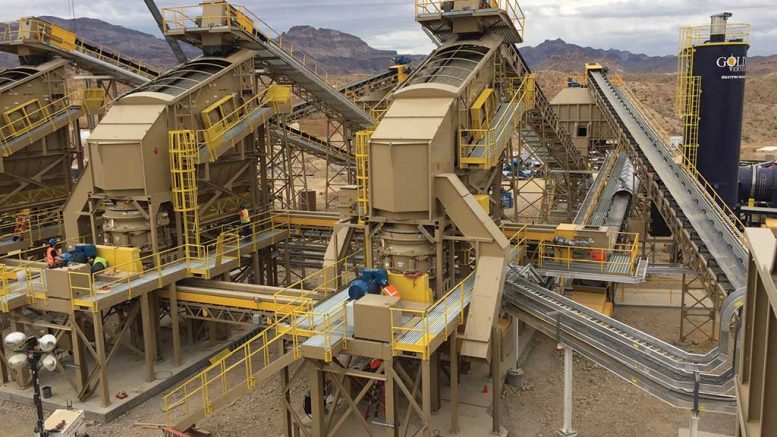Northern Vertex Mining (TSXV: NEE) has released a new preliminary economic assessment (PEA) for its Moss gold-silver mine in northwest Arizona that would double the amount of mineable material by including resources on unpatented mining claims.
The plan includes expanding the mine facilities onto federal public lands and would require the Bureau of Land Management (BLM) to approve a new mine plan of operations and amendments to several permits.
“We’re actually going to be up and running here in the next six weeks,” Northern Vertex president and CEO Kenneth Berry says in an interview with The Northern Miner. “We’ll be pouring gold and generating economic activity with up to 100 employees, so we see the expansion of this project as being the normal course.”
The current facility is expected to produce 5,000 tonnes per day over five years for a total 8 million tonnes grading 0.82 gram gold per tonne and 9.29 grams silver per tonne for 211,130 oz. gold and 2.4 million oz. silver, according to a June 2015 feasibility study.
But that’s only half of the available resource. Northern Vertex says the phase-two pit design was constrained by property boundaries and water — not by economics.
“We’ve removed the restraints of the private patented boundary,” Berry says. “When the project was scoped out we hadn’t drilled off sufficient water. We now have more than enough water supply for mining purposes, so this allows us to scale up our production profile.”

The Moss mine processing facility in Arizona. Credit: Northern Vertex.
Under the new PEA, Northern Vertex could mine 15.3 million measured and indicated tonnes grading 0.72 gram gold and 8.68 grams silver to produce 357,000 oz. gold and 4.3 million oz. silver over 10 years, plus 1.8 million inferred tonnes grading 0.44 gram gold and 5.37 grams silver for 5,000 oz. gold and 308,000 oz. silver.
The new PEA uses the same metrics as the feasibility study, including US$1,250 per oz. gold and US$20 per oz. silver. It also assumes the company could incorporate the expanded resource into production before depleting the phase-two pit. Northern Vertex says this would provide a “more efficient extraction plan” with a “more favourable production schedule.”
According to the PEA, the phase-two crushing and agglomeration plant will suit the life-of-mine operation, but another heap-leach pad would be almost entirely on BLM lands. Northern Vertex then redesigned phase two to avoid relocating the crushing plant in the mine’s third year, as was assumed in the feasibility study. It also includes a new power source to make the mine more efficient.

Processing facilities at Northern Vertex Mining’s Moss gold-silver mine in northwest Arizona. Credit: Northern Vertex Mining.
“We’re currently in the process of permitting a power line to our site,” Berry says, “which is going to replace the generators that have been purchased and will get the project up and running. The power line replaces the generators and it will save 5,600 gallons of diesel per day.”
The plan is to have the new heap leach pad operating by the end of the mine’s third year, which increases production to a peak 60,000 equivalent oz. gold in its fourth year. Production was previously anticipated to peak in the third year at 47,000 equivalent oz. gold, with fourth-year production pegged at 35,200 equivalent oz. gold.
The PEA estimates capital expenses at US$61.6 million, including US$37.5 million in sunk costs for building the phase-two mine. Operating costs are estimated at US$190 million. The after-tax internal rate of return is 52.5%, with an after tax net present value of US$93 million at a 5% discount rate.
Northern Vertex has funded the project in part through several private financings over the past seven years, including two in November 2012 for $7.5 million and $9 million.
“The financings that we’ve conducted since 2011 through to 2015 speak for themselves,” Berry says. “Very few other companies were active in the sector and we were raising funds and developing during a challenging period when others were sitting idle.”
The Moss project encompasses 15 patented lode claims covering 1 sq. km and 468 unpatented lode claims for a total 40 square kilometres.
Northern Vertex recently received a US$5-million funding tranche and signed a US$6-million working capital deal. The funds will help see Northern Vertex through to production as it builds its Moss mine.
Shares of Northern Vertex are priced at 48¢ with a 52-week trading range of 36¢ to 70¢. The company has an $83-million market capitalization.
“It’s a project that has a lot of growth potential,” Berry says. “It has blue-sky exploration and is robust economically. It has an opportunity to throw off a lot of cash flow, and so we see this as the company builder.”


When will we get the opportunity to buy in????